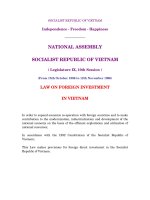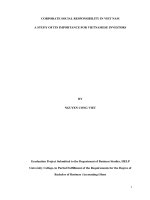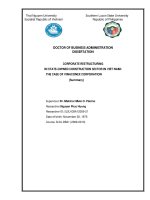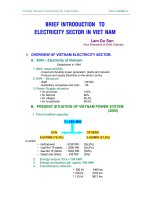Corporate restructuring in state -owned construction section sector in Viet Nam The case Vinaconex corporation
Bạn đang xem bản rút gọn của tài liệu. Xem và tải ngay bản đầy đủ của tài liệu tại đây (1.71 MB, 134 trang )
CORPORATE RESTRUCTURING IN STATE-OWNED
CONSTRUCTION SECTOR IN VIET NAM: THE
CASE OF VINACONEX CORPORATION
___________________________
A DISSERTATION
Presented to the Faculty of the Graduate School
Southern Luzon State University, Lucban, Quezon, Philippines
in Collaboration with
Thai Nguyen University, Socialist Republic of Vietnam
___________________________
In Partial Fulfillment
of the Requirements for the Degree
Doctor of Business Administration
___________________________
By
NGUYEN PHUC HUONG (PETER HEER)
December 2013
i
APPROVAL SHEET
The Dissertation of
NGUYEN PHUC HUONG
Entitled
CORPORATE RESTRUCTURING IN STATE-OWNED CONSTRUCTION
SECTOR IN VIET NAM: THE CASE OF VINACONEX CORPORATION
Submitted in Partial Fulfillment of the Requirements for the Degree
DOCTOR OF BUSINESS ADMINISTRATION
A program jointly offered by Southern Luzon State University,
Republic of the Philippines and Thai Nguyen University,
Socialist Republic of Vietnam
has been approved by Oral Examination Committee
WALBERTO A.MACARAAN, Ph.D.
Expert
EDWIN P. BERNAL Ph.D.
Expert
EDUARDO T. BAGTANG, Ph.D.
Expert
ALICE T. VALERIO, Ph.D.
Expert
CECILIA N. GASCON, Ph.D.
Chairman
Endorsed by:
MELCHOR MELO O. PLACINO,
Ph.D.
Adviser
Recommended by:
APOLONIA A ESPINOSA,
Ph.D.
Dean
Accepted in Partial Fulfillment of the Requirements for the Degree
Doctor of Business Administration
_____________________
Date
WALBERTO A. MACARAAN, Ph.D.
Vice President for Academic Affairs
ii
CERTIFICATE OF ORIGINALITY
This is to certify that the research work / dissertation entitled:
CORPORATE RESTRUCTURING IN STATE-OWNED CONSTRUCTION
SECTOR IN VIET NAM: THE CASE OF VINACONEX CORPORATION, orally
defended/ presented under the DBA Program jointly offered by Southern
Luzon State University of the Republic of the Philippines and Thai Nguyen
University of the Socialist Republic of Vietnam, embodies the result of original
and scholarly work carried out by the undersigned.
This dissertation does not contain words or ideas taken from published
sources or written works by other persons which have been accepted as basis
for the award of any degree from other higher education institutions, except
where proper referencing and acknowledgement were made.
_____________________
Researcher/Candidate: NGUYEN PHUC HUONG
Date Orally Defended: December 14th, 2013
Noted:
iii
ACKNOWLEDGMENT
During completion of this study, the researcher has received significant
support and collaboration from many organizations and individuals.
First and foremost, he likes to take this opportunity to express my
profound gratitude and deep regards to my guide Dr. Melchor Melo O.
Placino from Southern Luzon State University for his exemplary guidance,
monitoring and constant encouragement throughout the course of this
dissertation.
He would also like to thank PhD. Nguyen Ngoc Thang from Vietnam
National University Hanoi, Asst. Prof. Tran Thi Kim Thu, Ph.D, Head of
Faculty of Statistics - National Economics University and all his best friends
who have supported and encouraged him to complete this dissertation.
He also wants to acknowledge the contributions of his colleagues at
subsidiaries of VINACONEX Corporation during the conduct by distributing
and collecting the survey questionnaires. Without this support, he could not
have gathered large database for research and analysis. Also, he likes to
confer his gratitude to all Vinaconex leaders, other state-owned enterprises
leaders and some MOC managers.
Lastly, he wants to express his special thanks to Thai Nguyen
University and Southern Luzon State University for their cooperation in this
training program which provides him with an opportunity to partake and
conduct this study.
Nguyen Phuc Huong
iv
DEDICATION
This dissertation is dedicated to the following persons who have been
the source of my energy and strength.
To my ever loving father and to all my children who gave me the vitality
and inspiration to complete my DBA study and my dissertation.
Most especially, to my wife, Nguyen Thi Huong, for her love and for
believing in my abilities; for her sacrifices and understanding of leaving our
home every Saturday, Sunday and often come home late after official working
time to attend the DBA class, especially during the conduct of my dissertation,
and most importantly for taking care of our home and our family.
To my friends and collaborative partners, who had always been with
me and never ceased to support me.
NPH
v
TABLE OF CONTENTS
PAGE
TITLE PAGE ………………………………………………………………..
i
APPROVAL SHEET ……………………………………………………….
ii
CERTIFICATE OF ORIGINALITY ………………………………………..
iii
ACKNOWLEDGEMENT …………………………………………………..
iv
DEDICATION ………………………………………………………………
v
TABLE OF CONTENTS …………………………………………………..
vi
LIST OF TABLES ………………………………………………………….
viii
LIST OF FIGURES ………………………………………………………...
x
LIST OF APPENDICES …………………………………………………...
xi
ABSTRACT …………………………………………………………………
xii
CHAPTER
I
II
III
INTRODUCTION ……………………………………………
1
Background of the Study …………………………………..
3
Statement of the Problem ………………………………….
6
Objectives of the Study …………………………………….
7
Research Questions …………………………………….
8
Scope and Limitations of the Study ………………………
8
Significance of the Study …………………………………..
9
Definition of Terms ………………………………………….
11
REVIEW OF LITERATURE ……………………………….
13
Theoretical Framework ………………………………….…
26
METHODOLOGY …………………………………………..
31
Locale of the Study …………………………………………
31
Research Design ……………………………………………
31
Population, Sample and Sampling Technique …………..
32
Research Instrument ……………………………………….
33
Data Gathering Procedure …………………………………
34
Statistical Analysis ………………………........…….……
35
vi
IV
Statistical Treatment ………………………........…….……
36
RESULTS AND DISCUSSIONS ………………………….
37
Overview of the Vinaconex Corporation …..………...……
37
General points………………………………………………..
41
Analysis on each issue relating to restructuring process
44
Analysis of differences in opinions of staffs at different
ages about key issues …………………………….…...
V
65
SUMMARY OF FINDINGS, CONCLUSIONS AND
RECOMMENDATIONS …………………………………….
67
Summary of Findings ………………………………….……
67
Conclusions …………………………………….……………
71
Recommendations …………………………….……………
72
REFERENCES …….………………...………...…………………………..
75
APPENDICES ……………………………………………………………...
78
CURRICULUM VITAE …………………………………………………….
118
vii
LIST OF TABLES
TABLE
PAGE
1
Financial Data of Vinaconex for the Past Three Years ……
39
2
The Qualifications of Vinaconex Employees ………………..
39
3
Vinaconex’s Contributed Capital in Subsidiaries and
Affiliates …………………………………………………………
40
Vinaconex’s Contributed Capital to the Different Business
Sectors ………………………………………………………….
40
5
Profile of the Respondents …………………………………..
42
6
Reliability Statistics …………………………………………….
44
7
Reasons for Corporate Restructuring ……………………….
45
8
Perceptions of the Employees on Corporate Restructuring
46
9
Perceptions of Respondents About Competition During
Corporate Restructuring ………………………………………
47
Perceptions of the Respondents in Different Job Positions
about Competition ……………………………………………..
48
Perceptions of the Respondents about Strategy during
Corporate Restructuring ………………………………………
48
Perceptions of Respondents in Different Job Positions
about Strategy ………………………………………………….
49
Pearson Chi-Square Tests (Focus on their Core Business
Areas) …………………………………………………………...
50
Perception about Conflicts Regarding Corporate
Restructuring …………………………………………………...
51
Perception of Respondents in Different Job Positions
about Conflict in Benefits ……………………….…………….
52
16
Pearson Chi-Square Tests (Conflicts in Perception) ………
53
17
Perception of the Respondents about Ownership in
Corporate Restructuring ………………………………………
53
4
10
11
12
13
14
15
viii
TABLE
18
PAGE
Perception of the Respondents in Different Job Positions
about the Role of Majority Shareholders ……………………
54
Pearson Chi-Square Tests (The Role of Majority
Shareholders) …………………………………………………..
54
20
Perception about Leadership in Corporate Restructuring …
56
21
Perceptions of Respondents in Different Job Positions
about the Role of Shareholders ………………………………
57
22
Pearson Chi-Square Tests (Knowledge of BOM members)
57
23
Perception about Employment in Corporate Restructuring
58
24
Perception of Respondents in Different Job Positions
about Opportunity to Adjust Personnel ……………………...
59
Pearson Chi-Square Tests (Opportunity to Adjust
Personnel) ………………………………………………………
59
Perception of the Respondents about Technological
Innovation in Corporate Restructuring ………………………
60
Perceptions of the Respondents in Different Job Positions
about Technological Innovation Demands ………………….
61
Perceptions about Corporate Governance in Corporate
Restructuring …………………………………………………...
62
Perceptions of the Respondents in Different Job Positions
about Corporate Governance ………………………………...
62
Pearson Chi-Square Tests (Reforming the management
approach and methods) ………………………………………
63
31
Perceptions about Finance in Corporate Restructuring …...
63
32
Perceptions of the Respondents in Different Job Positions
about Capital Preservation in Enterprises …………………..
64
Pearson Chi-Square Test (Capital Preservations in
Enterprises) …………………………………………………….
65
Average Score of Different Ages in Assessment of Key
Issues …………………………………………………………...
65
19
25
26
27
28
29
30
33
34
ix
LIST OF FIGURES
FIGURE
PAGE
1
Kurt Lewin’s Change Management Model ……………………
27
2
The Relationship between the Dependent Variable
(Corporate Restructuring) and Independent Variable ……….
30
3
Organization Chart of Vinaconex ………………………………
41
4
Age Structure Based on Job Position …………………………
43
x
LIST OF APPENDICES
APPENDIX
PAGE
A
Questionnaire ………………………………………………...
79
B
Description of Respondents ………………………………...
85
C
Testing scale …………………………………………………
87
D
Statistics ………………………………………………………
88
E
Frequency Table ……………………………………………..
90
F
The relationship between the position and Q1.2 ; Q2.2;
Q3.1; Q4.2; Q5.1; Q5.3; Q6.4; Q7.1; Q8.1; Q8.3; Q9.1;
Q10.2; Q10.3 …………………………………………………
99
Point average - the age of the respondents ………...........
113
G
`
xi
ABSTRACT
Title of Research
: CORPORATE RESTRUCTURING IN STATE-
OWNED CONSTRUCTION SECTOR IN
VIETNAM: THE CASE OF VINACONEX
CORPORATION
Researcher
: NGUYEN PHUC HUONG (PETER HEER)
Degree Conferred
: DOCTOR OF BUSINESS ADMINISTRATION
Name and Address
of Institution
: Southern Luzon State University Lucban, Quezon,
Philippines and Thai Nguyen University, Socialist
Republic of Vietnam
Adviser
: Dr. Melchor Melo O. Placino
Year Written
: 2013
______________________________________________________________
The study of corporate restructuring in state-owned enterprises has
been the hot topic in the academe. However, the interests of researcher have
focused on investigating the phenomena of corporate restructuring more in
the developed countries than in the developing countries. There is very study
has been done in investigating the corporate restructuring in state-own
enterprises in Vietnam. This is the first study that devotes to explore the
corporate restructuring in a specific construction company in Vietnam Vinaconex. This study aimed to investigate what problems and issues arise to
corporate restructuring in Vinaconex. More specifically, this study would like to
examine the effects of ownership structure, level of diversification, firm's size
on firm's performance of this company. After that, it proposed a best model for
Vinaconex after restructuring and provided suggestions for Vietnamese policy
makers on state-owned enterprises restructuring.
xii
To collect data for this study, a typical five-level Likert item
questionnaire was designed for the data collection. The questionnaire was
consisted of thirty five (35) statements related to competition, financial,
corporate
governance,
new
business
strategies,
human
resource
management, conflict, ownership, leadership, technology development, and
company’s development. This study utilized 400 respondents who gave
information necessary to code all of the variables required for this study. From
the survey, the study analyzed the problems and issues that arise from the
restructuring in construction sector, and the social impact of restructuring on
the stakeholders. The findings revealed that majority of respondents strongly
agreed that the restructuring from their urgent needs aimed to help them
come out of recession, or avoid bankruptcy. In addition, the company’s
restructuring decision was determined by the company’s internal and external
factors.
Based on the findings, solutions were proposed to deal with problems
that arise from the restructuring of this company. Vinaconex needs (1) to pay
more attention to training on management for managers and carried out
technological innovation; (2) to focus on two major business areas to achieve
its vision, which is to become the leading company in the area of
development, investment and management of Construction and Real Estate;
(3) to develop effective management mode, transparent to avoid risks better;
(4) to develop strategies for long-term financial management to ensure the
sustainable development of the corporation; (5) to manage and better control
by increasing accountability for the operation of each unit member. The result
of study provided pieces of evidence for the theories about corporate
xiii
restructuring and contributed to the growing knowledge in strategic
management by using the specific Vietnamese case. In this study, limitations
and recommendations were also drawn for future researchers.
xiv
1
Chapter I
INTRODUCTION
Vietnam government recently issued policies about Restructuring of
state enterprises and Equitized enterprises whose charter capital is held over
50% by the State in Viet Nam focusing on economic groups and state-owned
corporations in order to achieve the following objectives:
- State-owned enterprises and Equitized enterprises whose charter
capital is held over 50% by the State have a more reasonable structure,
concentrating on key sectors and areas, providing products, essential public
services for society, security and national defense, being the hub for the state
economy to perform the leading role and the important material force for the
State to orient and regulate the economy and stabilize the macro-economic.
- Improving competitiveness, the rate of return on equity for
enterprises; completing the task of production and providing products,
essential public services for society, security and national defense for public
utility enterprises.
Since December 2006, VINACONEX (Vietnam Construction and
Import-Export Joint Stock Corporation) has implemented SOE privatization
policy. It is one of the first corporations that has successfully privatized in the
whole Corporation and become a Joint Stock Enterprise owned and controlled
by the Government in line with Business Law of Vietnam. Also, it has initially
achieved great success. Since the Corporation was established, VINACONEX
has followed diversification strategy on production and business aspects and
gained many proud achievements as well as has been highly appreciated by
2
clients, business community and society. However, lately in the context of
complicatedly and unexpected ever-changing macroeconomic such as highly
increasing inflation in a long time, sign of emerging deflation, tight monetary
policy, tight real estate policy and Government’s public investment cutting,
etc., enterprises in the construction sector in general and VINACONEX in
particular have coped with a lot of difficulties.
Currently, more than ever, it is compulsory to restructure the
Corporation when the Corporation has certainly developed and has been
notably coping with economic instability in a long time. Consequently, the old
activity model is not compatible with new context. VINACONEX has been
confronting
with
serious
requirements
on
restructuring
to
improve
competitiveness capacity, maintain strong points and steadily overcome the
crisis. VINACONEX is not allowed to make mistake in restructuring because
this mistake in such important task is synonymous with failure and difficulty in
recovering from business activities. Based on the problems for academic
discussion and real requirements above, the author has selected the topic:
“Corporate Restructuring in State-owned Construction sector in Vietnam – the
case of VINACONEX.” as thesis topic for DBA program.
Being one of
managers in VINACONEX, the author has recognized that research in the
topic is realistic. It will help the Corporation to enhance and complete
restructuring activities and helps VINACONEX Board of Management to
update current knowledge and reality (case study) to make optimal
restructuring strategies with high application and to be able to forecast as well
as estimate instability in the future. In addition, a new structure, transparent
and effective management will contribute to helping VINACONEX become
3
attractive to international and national investors, strategic partners. That
pushes VINACONEX to comprehensively develop to become one of leading
strong corporations in construction section in Vietnam and orient to a
construction corporation with certain trademark and share in the area.
Background of the Study
Vietnam embarked on the Doi Moi (renovation) policy in 1986. Since
then, the country has experienced radical changes, first is on its fundamental
economic thinking. The centrally planned economy a-la-the Soviet Union was
replaced by a market economy, albeit of a socialist character, which started
with a sweeping restructuring of the state-owned sector. This allowed the
private sector to join the economy, which facilitated the process of full
integration into the region and world mainstream. During 20 years of Doi Moi,
the gross domestic product (GDP) of Vietnam has seen sustained growth
(Central Institute of Economic Management, CIEM, 2006). The rate of
increase was 8.2 per cent each year on average in the 1991–1995 period,
reaching 8.5 percent in 2007 (General Office of Statistics, 2008). The Doi Moi
(renovation), economics growing, competition and globalization along with
tightened fiscal policies are causing both private and public sector
Vietnamese enterprises to strive for greater efficiency and higher costeffectiveness. In many cases the desired results cannot be achieved without
subjecting the corporate strategy and structure to some transformation. In this
context, restructuring is no longer just an option. It is a necessity for survival
and growth (Cascio, 2002).
The major objective of Vietnam’s reform process is to create a market
economy with socialist characteristics. The enterprise reforms in Vietnam
4
have three main components (Central Institute of Economic Management,
CIEM, 2006). The first component comprises state-owned enterprises (SOE)
privatization and restructuring to alleviate the problems that are impairing
enterprises’ ability to compete. The second component is to improve
enterprise
behavior
by
establishing
effective
corporate
governance
mechanisms and strengthening financial discipline. The third one is provision
of supporting institutions and infrastructure needed for a market based
enterprise economy. Key restructuring is the development of social benefit
programs to deal with the economy adjustments entailed by reforms, allow
enterprises to focus on their commercial objectives and long term strategy.
Economic reform in Vietnam is shaped by several distinctive
characteristics, reflecting policy-imposed constraints and other special
characteristics of the economy. First, characteristic reflects the fundamental
policy choice that significant public ownership and control of industry will be
retained. This choice partly explains why enterprise reforms have been so
heavily focused on SOE (CIEM, 2006; Thang & Quang, 2007). Second,
competition is strong in many although not all industries (Martyn, 1995). The
economic behavior of enterprises has become increasingly responsive to
market forces as a result of competition, the growth of non-state enterprises,
and management reforms to SOE. The scope of public ownership has been
substantially narrowed in recent years while the scope for private ownership
has been widened. Third, most state-owned enterprises are the relatively
low level of revenues, which are partly a reflection of current structural
problems (Dockery &Herbert, 2000).
5
Restructuring and privatization are now widely seen as important
instruments of government policy for creating appropriate conditions for
enhanced economic growth and for redefining the role of the State (Cappelli,
1995; Morris et al. 1999; Alkhafaji, 1992). Many countries in every continent
have in recent years embarked on projects to privatize and restructure their
SOEs, including Argentina, Chile and Mexico in Latin America; China,
Malaysia, Pakistan and the Philippines in Asia; the United Kingdom and
France in Western Europe and the transition countries of Central and
Eastern Europe; as well as Cote d’Ivoire, Nigeria and Togo in Africa. Some
industrialized countries, including New Zealand and the United Kingdom,
and several developing countries, such as China and Mexico, have pursued
privatization programs that are both radical and ambitious in scale and
scope (Jun Zhao, 2009 Diana et. al, 1998).
Privatization and restructuring of the SOE sector in Vietnam is intended
to concentrate state ownership and control on a core of large enterprises in
strategic industries while withdrawing state ownership and support from small
and medium-sized enterprises. SOE restructuring is closely linked to the
economic restructuring of the enterprise sector as a whole and to corporate
governance reforms (CIEM, 2006). Creation of the strategic core of large SOE
involves their conversion into modern enterprises and the formation of large
enterprise groups that will be able to compete against large foreign
multinationals. These groups face important challenges in overcoming the
present problem of their SOE and in sustaining the efficiency and flexibility
that will be needed to compete successfully in international markets.
6
Statement of the Problem
In Vietnam, the SOEs are holding a key role in the national economy
and is making an important political mission in the country. SOEs have
occupied a big resource of the economy; however, their contributions to the
national economy have been limited in terms of contribution for GDP ratio,
offering employment, Factors usage efficiency of production (land, capital,
materials, etc). Specifically, the shortcomings of the SOEs and the need to
carry out necessary restructuring process as follows:
•
Effective Business of the SOEs is more and more reduced, the
financial situation of many SOEs are not safe and healthy. Profitability
from state capital is limited. Many SOEs have been latent risk and
disruption.
•
State policies of investment management have many shortcomings
that limited investment performance of SOEs. Results of SOEs perform
tasks are not commensurable with the scale of resources invested.
•
There are very few specific rules, institutions to manage the Group's
state economy, state corporations.
•
Government, ministries, industries, including the construction industry
has project for restructuring the economy. The construction sector
corporations also simultaneously make plan for restructuring the
economy of its business; but actually implementing specific process for
restructuring the economy in the construction business are confused,
and have not actually achieve the desired effect.
•
Currently, Vinaconex is a corporation headed scale construction sector
in Vietnam. Vnaconex Corporation is kind of joint-Stock companies with
7
controlled shares owned by State (> 51%) thereby Vinaconex has
status as mentioned above. Vinaconex recently has been processing
corporate
restructuring;
however
in
the
process
of
corporate
restructuring, the corporation has faced many of the problems that
previous inadequacies were not fully foreseen.
Being one of the senior managers in VINACONEX, the researcher has
recognized that research on the topic “CORPORATE RESTRUCTURING IN
STATE-OWNED CONSTRUCTION SECTOR IN VIETNAM: THE CASE OF
VINACONEX CORPORATION” will benefit the company in particular and
construction industry in general. The study aimed to draw a portion of system
problems in the process of corporate restructuring of state-owned construction
enterprises, as well as to determine the practical significance to the
construction industry in particular enterprises and SOEs in Vietnam.
Objectives of the Study
Generally, this study aimed to explore the phenomena of corporate
restructuring issues in the construction sector in Vietnam, particularly, the
relationship between restructuring and firm’s performance. It tried to fill the
gap of research on relationships between restructuring and financial
performance in transition economies in Vietnam.
Specifically, this study sought to answer the following questions:
1.) To determine the awareness of the managers of Vinaconex
Corporation on the concept and the implementation of the corporate
restructuring in state-owned firms in Vietnam.
2.) To identify the main factors or problems and issues that affects the
process of corporate restructuring at Vinaconex Corporation.
8
3.) To examine the effects on the ownership structure on the corporate
restructuring of the construction sector in the SOEs.
4.) To propose the most appropriate model for Vinaconex after
restructuring.
5.) To formulate policy suggestion to the government's to support
business sector in corporate restructuring.
Research Questions
To meet the said objectives, the following questions were addressed:
Q1: How do Vietnamese managers perceive and interpret corporate
restructuring?
Q2: What framework (factors/problems and issues) is used in analyzing
corporate restructuring in Vietnam SOEs?
Q3: How restructuring in the construction sector in SOEs affect the state
shareholders and the ownership structure?
Q4: What is the most appropriate model for VINACONEX Corporation after
restructuring?
Q5: What policy can be suggested in order to support a successful SOEs
restructuring?
Scope and Limitations of the Study
This study was focused on Vinaconex Corporation (include head-office
and all subsidiaries of Vinaconex). It is comprised of fifty eight (58)
companies; twenty nine (29) constructions and real estate companies, eight
(8) productions of construction material companies, ten (10) power and water
9
supply companies, four (4) insurance, finance and banking companies, and
seven (7) design consultancy and services, trade companies.
Then, for the research instrument, survey questionnaire was used. It
was primarily given to leaders, managers and experts. The actual survey data
were conducted last May, 2013. For the secondary data, it was based on
national statistics and company reports from 2010 to June 2013. There was a
limited sample in this study due to difficulties in identifying all Vinaconex
company and other limitations, the sample was mostly in Vinaconex
Corporation and some subsidiaries.
Significance of the Study
SOEs held a dominant role in the economic development. To assess
its role within the whole economy, it has been contributing to GDP, job and
income generation and national budget. Therefore, SOE reform is a key
element in the Vietnamese Government’s programmed of the Doi Moi
(renovation), under which mercerization and integration into the global
economy are occurring. The reform was intended to improve the efficiency
and profitability of SOEs by reducing excess capacity, shedding surplus labor,
lowering debt loads, and upgrading productive capacity. In addition, it is to
transform SOEs into market players by changing their ownership and
management so as to improve the competitiveness in the global market.
Furthermore, the economic effect of the restructuring programmed has
had great impact on enterprise development and growth. It is often believed
that restructuring has a positive impact on the performance of the company.
However, this is not always true in practice but its social consequences are
even troublesome. One of these consequences, as some scholars already
10
note, is a rapid transfer of state assets into the hands of managers and other
private individuals (Ding 2000). Another emerging consequence is that the
restructuring program has been accompanied by severe measures against
workers, including collective layoffs, deprivation of benefits, labor rights
abuses, and unstable working conditions. Lacking effective state protection as
well as organizations of their own, workers have become increasingly
vulnerable by despotic managerial power (Lee 1999).
In order to achieve desirable economic and social results in the
process of restructuring, management should always have a plan of action if
restructuring becomes inevitable. At the same time, SOEs should not be left
alone to carry out restructuring; governments too often feel the impact of the
restructuring of enterprises, especially in situations where whole sectors or
regions are affected. This study would not only answer those questions but it
would also expand knowledge and experience in the field of corporate
restructuring as well as in construction sector of Vietnam through the
examples from VINACONEX.
Corporate restructuring has been studied in Vietnam. However, there
are only few official researches on corporate restructuring in construction and
real estate corporation. Thus, it was expected that the study would contribute
not only in restructuring process for Vietnam but also systemizing and
developing corporate restructuring issues in general and restructuring of
corporations in construction sector in particular. VINACONEX was chosen for
case study of enterprise restructuring by analyzing the current structure and
by proposing a new structure and management model for the company in the
11
future. The results were expected to really contribute to complete the
restructuring process of VINACONEX.
Definition of Terms
Corporate restructuring is one of the most complex and fundamental
phenomena that management confronts. Each company has two opposing
strategies from which to choose: to diversify or to refocus on its core
business. While diversification represents the expansion of corporate
activities, refocusing characterizes a concentration on its core business. From
this perspective, corporate restructuring is a reduction in diversification.
Corporate restructuring entails a range of activities including portfolio
restructuring, financial restructuring, and organizational restructuring (Gibbs,
1993). Accordingly, portfolio restructuring involves the redeployment of
corporate assets through divestitures of business lines that are considered
peripheral to the core business strategy. Significant changes in a
corporation’s
capital
structure
are
termed
financial
restructuring.
In
organizational restructuring, the focus of change is on management and
internal corporate governance structures.
There are three major options for corporate restructuring includes
arranging a sell- off to a strategic buyer, externalizing an independent entity,
and liquidating (Achleitner, 2000 and Charifzadeh, 2002).
First, sell-offs as they are called, describe the sale of an affiliate
company or business unit to a strategic buyer. In these cases the buyer
normally purchases the whole business unit in order to exert full control.
The second group of restructuring concepts involve the separation of
an independent entity, and include (i) change in ownership of the affiliate









